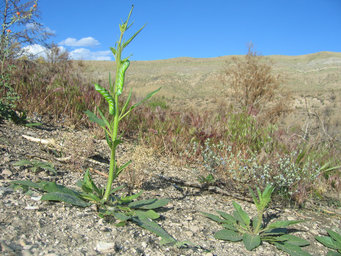Antagonistic Interactions Of Plant Defense Compounds
Tobacco hornworms neutralize different defense mechanisms of tobacco plants after ingestion
Tobacco hornworms neutralize different defense mechanisms of tobacco plants after ingestion
A combined defense of different chemical defense substances could result in a negative interaction and mutual detoxification, according to researchers at the Max Planck Institute for Chemical Ecology in a new study on the wild tobacco species Nicotiana attenuata and one of its specialized herbivores. Chemical analyses of frass revealed that larvae of the tobacco hawkmoth Manduca sexta are able to split off components of one defense substance and use them to detoxify another. However, tobacco plants have also developed a counter-strategy to minimize the mutual detoxification of their defenses: They avoid producing the two substances involved in detoxification simultaneously in high concentrations (PNAS, doi: 10.1073/pnas.212280811).
 Tobacco hornworm larvae (Manduca sexta) on a Nicotiana attenuata plant.© Danny Kessler
Tobacco hornworm larvae (Manduca sexta) on a Nicotiana attenuata plant.© Danny Kessler
In chemical pest control, but also in medical treatment of diseases, it is often recommended to rely on a combination therapy of different agents in order to achieve the best success. However, many drug package inserts point out that there can be interactions between different active ingredients, which can not only enhance the effect of a drug, but also weaken it or even cancel it out. Researchers from the Max Planck Institute for Chemical Ecology in Jena, Germany, have now come across such an unexpected effect when studying defense mechanisms in the wild tobacco Nicotiana attenuata. They showed that larvae of the tobacco hawkmoth Manduca sexta are able to use two different plant defenses to counteract the harmful effect of the other.
The study is based on chemical analyses of caterpillar frass. "We were able to identify previously unknown chemical substances in the caterpillars' frass. However, we found that they shared structural features of two plant defense compounds. Therefore, the key questions for us were: Can we isolate the components and prove their structure, and, most importantly: Can we show from which specialized signaling pathways they originate and what function they have?" first author Sven Heiling summarizes the initial questions of the study.
The researchers used comparative mass spectrometry analyses of the plant metabolites and the frass of the caterpillars that had fed on these plants. They were able to show that Manduca sexta larvae are able to convert two different known plant defense substances – chlorogenic acid, a phenolic ester of caffeic acid and quinic acid, and 17-hydroxygeranyllinalool diterpene glycosides, or HGL-DTGs for short – after ingestion of leaf tissue. The binding of chlorogenic acid to certain sugars of the HGL-DTG molecules makes the two parent compounds less effective against herbivores.
These results were supported by feeding experiments with caterpillars on leaves of plants that had been modified to disable one of the two defense mechanisms. The researchers were thus able to show not only that the compounds detected in the larval frass originated from chlorogenic acids and HGL-DTGs ingested with the plant food, but also that caterpillars fed with leaves unable to produce either defense grew better than caterpillars in which only the production of HGL-DTGs had been inactivated.
However, the researchers went one step further and wanted to know how plants deal with this dilemma in nature. Given the long evolutionary history of the “arms race” between plants and insects, they wondered what response tobacco plants have to Manduca sexta’s clever detoxification strategy. Therefore, they studied the biochemical properties of tobacco plants in different natural habitats. "We looked at 183 natural accessions, that is, material of Nicotiana attenuata collected at a specific location at specific times. What was striking was that plants from different habitats seem to select the compounds that are essential for them to adapt to their specific environment, and suppress the production of the other compounds. This chemical pattern may help them avoid the mutual detoxification to some extent," says co-author Jiancai Li.
The study represents an impressive example of the evolution of plant defenses on the one hand, and the adaptation processes of an insect that specializes in feeding this plant, such as the tobacco hornworm, on the other. It has been shown for the first time that a combined defense consisting of different defense substances can be "sabotaged" by an herbivore in such a way that two active compounds detoxify each other by enzymatic conversion after ingestion. Presumably, there are many other examples in nature of the sophisticated detoxification strategies deployed by specialist insect herbivores. However, such research approaches are not well established because it is difficult to identify chemical changes in substances after ingestion by herbivores.
In order to elucidate detoxification strategies of insects, Ian Baldwin and his colleagues use a new research approach called "frassomics", which enables them to describe the chemical conversion of plant metabolites in the insect by analyzing their frass. The scientists expect to uncover many more similar examples – due to new advances in mass spectrometry, as well as larger spectral databases, and novel algorithms for identifying similar compounds. They want to find out in a next step, which enzyme Manduca sexta larvae use for the mutual detoxification of the plant defenses, and to study the evolutionary origin of this enzyme in more detail.
Publication: Sven Heiling, et al., The downside of metabolic diversity: Postingestive rearrangements by specialized insects, Ecology (2022). DOI: 10.1073/pnas.2122808119.
Original Story Source: Max Planck Institute for Chemical Ecology

 Alerts Sign-up
Alerts Sign-up